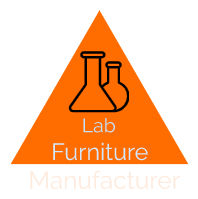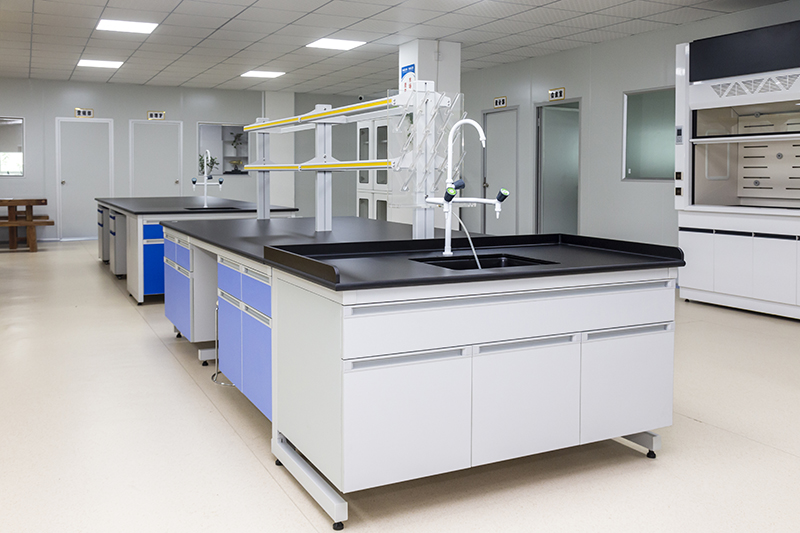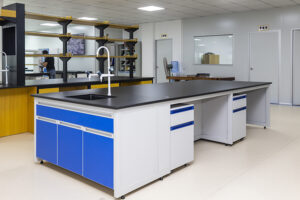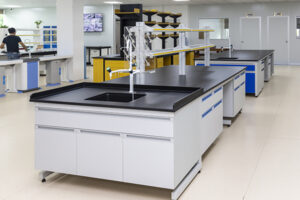With the advancement of science, laboratories are increasingly widely used in primary and secondary schools, colleges, and universities and have become an indispensable part of teaching. Therefore, the safety requirements of the teaching system laboratory are relatively strict, and the ventilation system, fire protection engineering, water, and electricity circuit system, laboratory furniture, etc., all need to be designed and laid out in strict accordance with the standards. So how should the decoration design of the university laboratory be done?
Table of Contents
Classification of University Laboratory
First of all, let’s understand the classification of laboratory construction in colleges and universities:
Laboratory classification mainly includes
Physical Laboratory
Chemical Laboratory
Biological Laboratory
Psychological Laboratory
Among them,bio safety laboratories can be divided into
P1-level biosafety laboratories
P2-level biosafety laboratories
P3-level biosafety laboratories
P4-level biosafety laboratories
According to safety levels. In addition, each type of laboratory has specific experimental area planning requirements; for example, chemical experiments should include: volumetric analysis, routine analysis, sample preparation laboratory, etc.
The Overall Plan for University Laboratory Construction
Water Supply System
Conventional water includes ordinary tap water, distilled water, and ultra-pure water. Good planning should be considered during construction, and materials like water supply pipes and joints should be selected according to specific experiments. Also, consider the separation of water and electricity, the environment around the water pipe, the direction of the waterway, etc. The sewage is more critical, divided into polluted water and non-polluted water, such as acidic water, solid alkaline water, heavy metal contaminated water, etc. These waters must be treated by environmental protection equipment before they can be discharged.
Electric Circuit
There should be a reasonable plan for the electricity consumption of weak electricity, lighting electricity, and experimental equipment, especially the electricity consumption of instruments and equipment. Insufficient electricity will affect the instrument’s service life and bring some stable factors to the experiment. It should also control and reduce the current fluctuation, reduce or stabilize the changing value of harmonics, reduce or reduce the interference of the magnetic field, and so on.
Power supply considerations for university laboratory decoration design:
The power required by all the instruments in the laboratory and the number of required electrical sockets are reasonably arranged and easy to use.
The electrical socket is three-hole or two-hole.
The voltage and power required by the instrument.
The sockets required by the computer should be fully considered.
Gas Supply
High-purity gas pollution mainly occurs in storage, transportation, and measurement. During the use process, the airtightness of the gas cylinder and the transmission system should be checked frequently. If a gas leakage is found, measures should be taken in time. In the laboratory, where conditions permit, a particular gas storage room with gas cylinder storage cabinet should be set up to separate the oxidizing gas from the reducing gas and the flammable gas from the non-flammable gas to prevent accidents.
Exhaust
This is an essential part of the laboratory. It is generally divided into local and global. It is perceived as local exhaust. For example, experiments prone to generate harmful gases during operation need to be carried out in the exhaust equipment. That is, fume hoods or universal exhaust hoods and atomic absorption hoods. During construction, attention should be paid to whether the exhaust wind speed is uniform.
Material
According to different experimental properties, choose other materials to adapt to the laboratory environment, such as corrosion; it depends on whether it is acidic, alkaline, or inorganic. Then select materials suitable for the degree of corrosion resistance to satisfy the laboratory furniture.
Lab Furniture
The teaching system laboratory’s setting is mainly for teaching, and the testing process is relatively simple and fixed. The requirements for laboratory furniture are mainly essential laboratory equipment, including phenolic work benches or epoxy resin work benches,fume hoods, storage cabinets, laboratory chair, etc.
Planning and Design Tips




